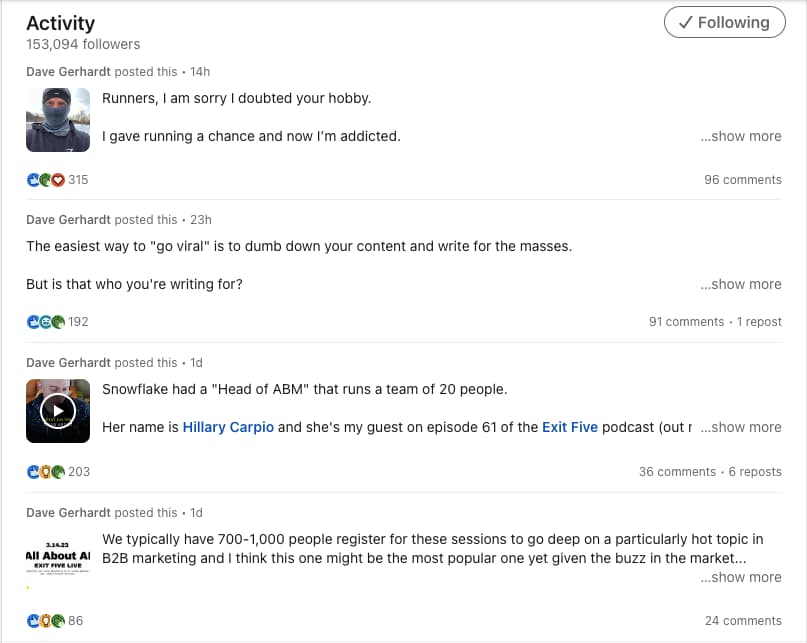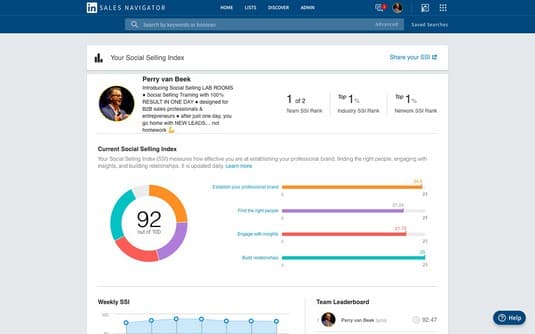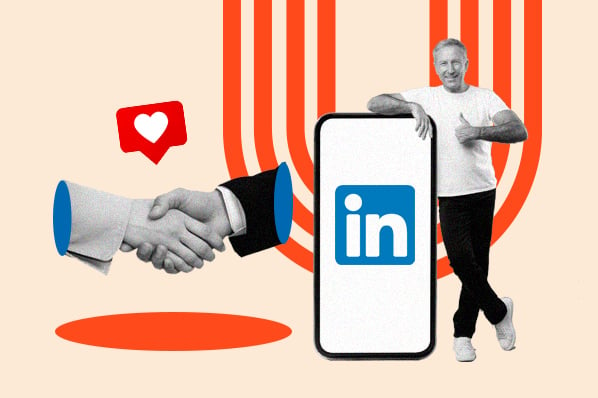Table of Contents
- What is LinkedIn’s Social Selling Index?
- The Benefits of Using LinkedIn’s Social Selling Index
- How LinkedIn’s Social Selling Index Works
- How to Find Your LinkedIn Social Selling Index Score
The Social Selling Index was developed in 2014, after identifying the platform’s top sales professionals and analyzing their in-app behavior. In 2015, it became part of LinkedIn’s Sales Navigator, a subscription-based feature.
Now, the feature has become available to anyone with a LinkedIn account.
The Benefits of Using LinkedIn’s Social Selling Index
Here are the three main benefits of tracking your LinkedIn Social Selling Index score:
1. The Opportunity to Boost Your Sales
LinkedIn claims that the higher your SSI score, the more likely you are to hit your sales targets. They reveal that professionals who track and maintain a high social selling score on LinkedIn have, on average:
- 45% more sales opportunities than professionals with lower scores.
- A 51% higher chance of meeting their quota.
- 78% more sales results than their counterparts who aren’t active on social media.

Naturally, these numbers might look different for you depending on your industry and network size. Still, since the formula circulates around the quality of your interactions and connections, it’s easy to see how a high score could deliver tangible results.
2. Improves Your Personal Brand
Checking where you stand on the SSI scale will help you build out and maintain your personal brand. Let’s assume your profile says you’re in the top 10% of professionals in your industry. This would mean that people see you as a thought leader in your field.
How does this translate to sales specifically? According to a joint study by LinkedIn and Edelman, 58% of business leaders are willing to buy from an industry expert. They are also inclined to pay more, as they feel they will receive a premium service.
3. Measures the Effectiveness of Your LinkedIn Posts
Checking your SSI regularly will help you track how your activities on the platform resonate with your audience. You can use it to see how any change in the type of content you share, post length, or frequency of posts affects your visibility.
Say that so far, you’ve only been re-sharing others’ posts. Though they were insightful and always collected a few likes and comments, you weren’t exactly contributing to the “Establish your professional brand” ingredient of the score.
After posting original content for two months, you’ve noticed that your professional branding ranks went up from a 6 to a 17 score.
As you can see, giving a score to your thought leadership and social sales efforts motivates you to become better at what you do.
Now that you know why it’s worth checking your LinkedIn SSI score, let’s look at how their formula works.
How LinkedIn’s Social Selling Index Works
To calculate your Social Selling Index, LinkedIn takes into account four pillars:
- Establishing a professional brand. This category evaluates two elements: The completeness of your LinkedIn profile and the quality of content that you post.
- LinkedIn checks if you have a profile photo, a detailed job history, recommendations, etc.
- The platform also looks at the number of posts you publish and how many likes and comments you get. Naturally, the more detailed your profile and the better your content, the higher your score.
- Finding the right people. This metric revolves around Sales Navigator, so it might be harder for you to get a decent score if you're a free LinkedIn user. The brand does it to encourage more people to use their tools to find new contacts and connect with them.
- If you get in touch with the right person — for instance, a decision maker — you boost your chances of making a sale.
- Engaging with insights. Sharing popular content can help you get a high score in this category. Overall, the more posts you share and the more engagement they receive, the better your score.
- Don’t forget to also comment on and like other users’ posts.
- Remember that a simple “thanks for sharing” or “great post” won’t suffice. LinkedIn now evaluates the length of the comments to ensure good quality.
- Building relationships. This final metric focuses on managing your network. It checks how often you get in touch with your contacts and how effective your outreach is.
- If your messages remain without response, it negatively impacts your LinkedIn SSI score.
For each pillar, you can get between 0 and 25 points. Your LinkedIn SSI score is the sum of all the individual scores from the four pillars. The higher your SSI, the more influential your profile is.
What’s a good LinkedIn SSI score?
Your SSI is compared to other people from the same industry. That said, LinkedIn always assumes that you’re in sales. If you’re not, you’ll probably score lower than your sales friends.
Instead of trying to achieve a specific score, focus on being in the top 10% of your industry, unless you’re an industry leader. In this case, LinkedIn recommends aiming at an SSI score of 75 or higher. This will help you land a position as an Industry Thought Leader.
Why does my SSI score matter?
There are several reasons why it’s worth working on your LinkedIn Social Selling Index score. We’ll discuss each in detail below.
Firstly, the higher it is, the more people you can reach — and this matters. After all, what’s the point in producing great content, if no one reads it, right?
You have probably noticed how much engagement industry influencers, such as Dave Gerhardt, get on their posts. A high SSI gives them more exposure.

Secondly, your SSI gives you insights into your social selling campaigns' effectiveness. You can use it to verify what works and what needs improvement.
LinkedIn can be a great source of leads (I know from my own experience), provided that you connect with the right people and post content that resonates with them.
Remember that your SSI is a performance indicator, not a random number. It’s worth monitoring to check if your marketing efforts are paying off. If it goes down, you’re likely doing something wrong, and it’s time to investigate what that is.
You can check your score for each pillar. Maybe you connected with the wrong people. Or perhaps, your posts are of poor quality, so no one engages with them.
How to Find Your LinkedIn Social Selling Index Score
Finding your social selling index score couldn't be easier. All you have to do is click on this link. Just make sure you’re logged into LinkedIn. Alternatively, you can access it via Sales Navigator. Go to "Admin" and click on "User Report." Voila!

Investing in your LinkedIn SSI score pays off.
LinkedIn is a great platform for building meaningful connections and growing your sales pipeline. However, it doesn’t happen overnight and requires consistent effort.
Increasing your LinkedIn Social Selling Index score gives you a chance to increase your exposure and make sure your posts are relevant to your target audience.
Monitor it regularly to assess the performance of your marketing efforts. As soon as your score drops, try to find the root cause and act quickly. All that’s left to say is — good luck with growing your SSI score.
Social Selling on LinkedIn



![Here’s how to write a professional LinkedIn headline to 10x your presence [+ examples]](https://53.fs1.hubspotusercontent-na1.net/hubfs/53/linkedin%20headline%20featured.webp)
![15 Best LinkedIn Summary & Bio Examples [+ How to Write Your Own]](https://53.fs1.hubspotusercontent-na1.net/hubfs/53/linkedin-summary-examples-4.jpg)


.jpg)

![How to Write InMail Messages to Recruiters on LinkedIn [Samples + Templates]](https://53.fs1.hubspotusercontent-na1.net/hubfs/53/how-to-craft-an-inmail-that-gets-results-1.jpg)


![LinkedIn Prospecting Messages: How to Nail One [+ Templates]](https://53.fs1.hubspotusercontent-na1.net/hubfs/53/Linkedin%20prospecting%20messages%20(1).webp)